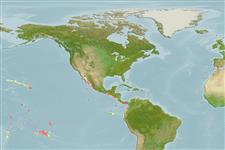>
Anguilliformes (Eels and morays) >
Chlopsidae (False morays)
Etymology: Chlopsis: Greek, chloea = green + Greek, opsis = appearance (Ref. 45335); kazuko: Named in honor of Kazuko Nakamura in recognition of her faithful and dedicated service to the LACM section of fishes by single-handedly archiving the Giles W. Mead ichthyological library (Ref. 40870).
Eponymy: Kazuko Nakamura was an archivist at the Los Angeles County Museum. She was honoured for “…single-handedly archiving the Giles W. Mead ichthyological library at the Los Angeles County Museum of Natural History.” (Ref. 128868), visit book page.
Environment: milieu / climate zone / depth range / distribution range
Ecología
marino demersal; rango de profundidad 50 - 100 m (Ref. 96339). Tropical
Eastern Central Pacific: Gulf of California. Mexico southward to Costa Rica (Ref. 97056).
Tamaño / Peso / Age
Maturity: Lm ? range ? - ? cm
Max length : 11.3 cm SL macho / no sexado; (Ref. 40870)
Short description
Claves de identificación | Morfología | Morfometría
Vértebra: 123 - 126. Head and body pigment uniformly distributed and sharply demarcated, heavily pigmented dorsally and unpigmented ventrally; dorsal fin origin over or in front of gill opening (Ref. 40870).
Life cycle and mating behavior
Madurez | Reproducción | Puesta | Huevos | Fecundidad | Larva
Lavenberg, R.J., 1988. Chlopsid eels of the eastern Pacific with a new species and descriptions of larval forms. Bull. Mar. Sci. 42(2):253-264. (Ref. 40870)
IUCN Red List Status (Ref. 130435: Version 2024-1)
Threat to humans
Harmless
Human uses
Herramientas
Special reports
Download XML
Fuentes de Internet
Estimates based on models
Preferred temperature (Ref.
123201): 15.5 - 21.6, mean 19.3 °C (based on 9 cells).
Phylogenetic diversity index (Ref.
82804): PD
50 = 0.5002 [Uniqueness, from 0.5 = low to 2.0 = high].
Bayesian length-weight: a=0.00102 (0.00046 - 0.00225), b=3.06 (2.88 - 3.24), in cm total length, based on all LWR estimates for this body shape (Ref.
93245).
Nivel trófico (Ref.
69278): 3.7 ±0.6 se; based on size and trophs of closest relatives
Fishing Vulnerability (Ref.
59153): Low vulnerability (10 of 100).
